Nanomaterials like Nanofibers Mimic Natural Tissues and Support Cell Growth in Tissue Engineering
Introduction
Nanomaterials, particularly nanofibers, have emerged as critical components in the field of tissue engineering due to their unique ability to mimic the structural and functional characteristics of natural tissues. This significance lies in their potential to enhance cell adhesion, proliferation, and differentiation, making them invaluable for regenerative medicine applications. By resembling the extracellular matrix (ECM) found in natural tissues, nanofibers promote an environment conducive to cell growth. This article delves into the implications of nanofibers within the broader context of Advanced Nanomaterials and their usage in enhancing tissue engineering methods.
Key Concepts
Structure and Properties of Nanofibers
Nanofibers are fibers with diameters at the nanometer scale, typically produced through techniques such as electrospinning. Their large surface area to volume ratio, porosity, and tunable mechanical properties make them ideal scaffolds for tissue engineering.
Mimicking Natural Tissues
By simulating the ECM, nanofibers provide structural support and biochemical signals that encourage healthy cell behaviors. This mimetic capability is a defining feature of Advanced Nanomaterials, highlighting their importance in modern biomedical applications.
Applications and Real-World Uses
The applications of nanomaterials like nanofibers in tissue engineering are vast and diverse. Here are a few notable examples:
- Wound Healing: Nanofibers are used to create scaffolds that accelerate the healing process.
- Bone Regeneration: Nanofibers embedded with bioactive molecules facilitate the regeneration of bone tissues.
- Cardiac Tissue Engineering: Nanofiber scaffolds support the growth of cardiac cells, promoting recovery after infarction.
These applications underline how nanomaterials are revolutionizing the field of advanced nanomaterials and tissue engineering by enhancing the integration and functionality of engineered tissues in clinical settings.
Current Challenges
Despite the promising advantages, several challenges persist in the study and application of nanomaterials like nanofibers:
- Scalability: Producing nanofibers at a commercial scale while maintaining quality is a significant hurdle.
- Biocompatibility: Ensuring that nanofibers are non-toxic and promote positive cellular responses remains a key concern.
- Regulatory Issues: The integration of new nanomaterials in medical applications often faces complex regulatory challenges.
Future Research and Innovations
Future research in nanomaterials like nanofibers focuses on innovative approaches to optimize their properties. Breakthroughs in bioprinting and biofunctionalization of nanofibers are anticipated to open new avenues for personalized medicine, allowing tailored tissue engineering solutions for patients. Furthermore, the incorporation of smart materials that respond to environmental cues may significantly enhance the effectiveness of tissue scaffolds.
Conclusion
In summary, nanomaterials like nanofibers play a transformative role in mimicking natural tissues and supporting cell growth within the realm of tissue engineering. As research progresses in the field of Advanced Nanomaterials, the potential applications for these innovative materials continue to expand, promising improved outcomes for patients undergoing regenerative treatments. For further reading on advanced topics in nanotechnology and tissue engineering, explore our related articles section.
